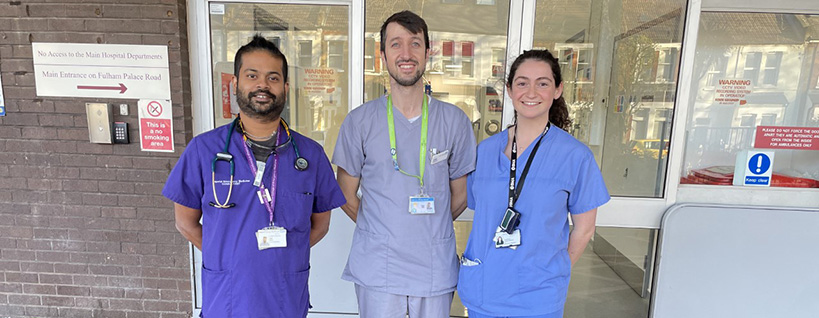Reducing unnecessary cannulation at Charing Cross Hospital

The issue
Over 1.4% of NHS supply chain emissions are due to single-use plastics. The NHS has committed to a 10% reduction in clinical single-use plastics in the short term, eventually saving a total of 224 ktCO2e.
The emergency departments at St Mary’s Hospital and Charing Cross Hospital, both part of Imperial College Healthcare NHS Trust, treat a range of life-threatening injuries and illnesses. Patients who clinicians believe might be seriously ill and attend Accident and Emergency (A&E), routinely receive a cannula just in case it is needed to support the administration of fluids and medicines. However, a significant proportion of these are not actually required during a patient’s time in A&E, contributing to a waste of equipment and staff time, as well as patient discomfort and increased risk of infection.
A baseline measurement carried out as part of a quality improvement project at Charing Cross Hospital Emergency Department (ED), found that:
- 86 per cent of patients attending a 24 hours consultant led A&E were cannulated
- over 40 per cent of the cannulas inserted upon attendance were not used
- a survey also revealed that 68 per cent of patients complained of pain and discomfort associated with cannulation
The multi-disciplinary team leading the project at Charing Cross Hospital estimated that unnecessary cannulation in the emergency department was potentially costing £125,000 and generating an excess of 24,000 KgCO2 per year.
The solution
The team initiated a year-long project to reduce unnecessary cannulation in the emergency department, led by Anu Mitra, emergency medicine consultant and quality improvement lead. The team worked to educate colleagues and change behaviour to support economical cannula use in the emergency department.
To raise awareness, the project team designed posters encouraging staff to ‘contemplate before you cannulate’. These highlighted patient comfort, cost considerations and environmental impact around unnecessary cannulation, alongside clear actions to take. These, along with other visual prompts were placed in key areas in the department, as well as on phlebotomy forms. The team also worked with all the emergency department consultants, drawing on clinical expertise and findings from the baseline measurement of unnecessary cannula-use to develop, agree and circulate ‘traffic light’ indications to help decide when cannulation is required. These clinical guidelines helped to give staff confidence they were making the right decisions for patients needing cannulation.
There was also direct engagement with phlebotomy and nursing staff to explain the importance of reducing cannula use, with a focus on specific areas in the emergency department where greater improvement was needed. Phlebotomy staff were empowered to question staff “is this cannula really necessary?” as a nudge to reconsider.
Additionally, a blood test ordering sheet – where patient details and blood labels are left for phlebotomy staff to pick up and go and take bloods – was altered slightly to include an area on the reason for needing a cannula.
The impact
An audit after 12 months showed a 25% decrease in cannulation during attendance in the emergency department, down to 61%. Of the patients cannulated during attendance, only 27% were unused, down from 40%. This constitutes a reduction of 40 unnecessary cannulations a day and suggests a potential annual reduction in associated carbon of around 19,000 kgCO2e with a cost saving of around £95,000.
Anu Mitra said: “Reducing unnecessary cannula use has improved patient comfort, created cost savings and reduced carbon emissions. While this was always a quality improvement project with sustainable healthcare in mind, the department was convinced of its potential to improve patient comfort and efficiency. I learned that we shouldn’t be afraid to initiate projects that ostensibly aim to reduce our environmental impact. Staff are really concerned about climate change, and there is an appetite to find ways to deliver sustainable healthcare”.
What’s next
Charing Cross Hospital emergency department plans to run the project for another year to embed further carbon savings, as well as introduce a number of other ‘green ED’ projects that will help to reduce their reliance on unsustainable practices and equipment.
Further information: Imperial College Healthcare NHS Trust | Our Green plan
Contact: imperial.communications@nhs.net
